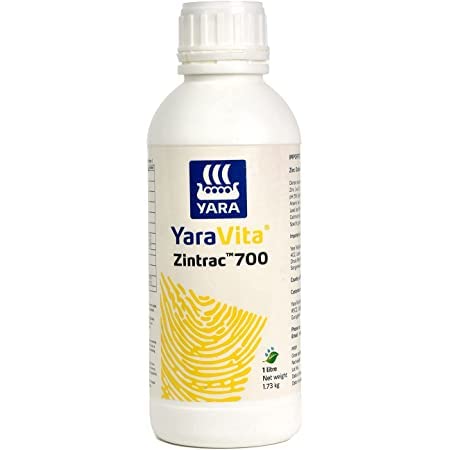-
Which is most useful fertilizer after Urea and DAP?
Regular price Rs. 890.00Regular priceUnit price / perRs. 964.00Sale price Rs. 890.00Sale -
Dr. Bacto's Biozinc 4K (Zinc solubilizing Bacteria) Dextrose Based probiotic Cultures Manufactured by Advanced Production Technology.
Regular price Rs. 680.00Regular priceUnit price / perRs. 980.00Sale price Rs. 680.00Sale -
RALLIS Boron 20% Plant Nutrition (250 GM)
Regular price Rs. 145.00Regular priceUnit price / perRs. 160.00Sale price Rs. 145.00Sale -
Biogreen Zinc Plus _ 500ML
Regular price Rs. 1,050.00Regular priceUnit price / per -
YaraVita Zintrac 700 (Zinc Oxide Suspension Concentrate 39.5% Zn)
Regular price Rs. 900.00Regular priceUnit price / perRs. 920.00Sale price Rs. 900.00Sale -
Crystal Talwar Zinc Super-14 Plant Nutrition (500) gm
Regular price Rs. 500.00Regular priceUnit price / perRs. 530.00Sale price Rs. 500.00Sale -
SHRIRAM BOSS with Boron 20% | Micronutrient for improved pollination | Boosting Flowering and Fruit Setting | Good for all Vegetables and Fruits | (100 Gram)
Regular price Rs. 113.00Regular priceUnit price / perRs. 125.00Sale price Rs. 113.00Sale -
Boron 20 (250gm)
Regular price Rs. 150.00Regular priceUnit price / per -
Casa De Amor Boric Acid
Regular price Rs. 519.00Regular priceUnit price / perRs. 999.00Sale price Rs. 519.00Sale -
Coromandel AcuMist Zinc 250ML
Regular price Rs. 500.00Regular priceUnit price / perRs. 999.00Sale price Rs. 500.00Sale -
Coromandel AcuMist Zinc 1Ltr
Regular price Rs. 999.00Regular priceUnit price / per -
Coromandel AcuMist Zinc 100ML
Regular price Rs. 350.00Regular priceUnit price / perRs. 600.00Sale price Rs. 350.00Sale -
Generic Yara Vita Zintrac 700
Regular price Rs. 950.00Regular priceUnit price / per -
Instacheal Zn 12% EDTA Chelated Zinc 12%, Chelated Zinc Micronutrient Powder Form
Regular price Rs. 1,003.00Regular priceUnit price / perRs. 1,415.00Sale price Rs. 1,003.00Sale -
Dr. Bacto's 5G BioZinc Bio Capsules, Zinc Solubilizing Bacteria Enclosed in Biodegradable Capsules which Having Ability to solubilize Zinc.
Regular price Rs. 719.00Regular priceUnit price / perRs. 1,075.00Sale price Rs. 719.00Sale
Collection: Micronutrients
Micronutrients are essential for plant growth and development, but they are required in very small quantities. Indian soils are generally poor in micronutrients, and their use has become increasingly important in recent decades to maintain high crop yields.
Some of the most important micronutrients for Indian agriculture include:
- Zinc
- Boron
- Iron
- Manganese
- Copper
- Molybdenum
Micronutrients can be applied to the soil or to the foliage of plants. Soil application is more common, but foliar application can be more effective for correcting micronutrient deficiencies that are already present in the plant.
Micronutrients can be used in a variety of forms, including:
- Sulphates
- Chelates
- Glycinates
- Proteates
- Boric acid
- Borax
- Disodium octaborate
- Potassium tetraborate
- Sodium molybdate
- Ammonium molybdate
It is important to note that using single micronutrients can give rise to toxicity problems. To avoid this, micronutrient mixtures are often used. Micronutrient mixtures can be formulated to meet the specific needs of different crops and soil types.
Micronutrient use in Indian agriculture has a number of benefits, including:
- Increased crop yields
- Improved crop quality
- Enhanced tolerance to pests and diseases
- Reduced use of chemical fertilizers
- Improved soil health
How to Use Micronutrients in Indian Agriculture
To use micronutrients effectively in Indian agriculture, it is important to:
- Test the soil to determine which micronutrients are deficient.
- Apply micronutrients at the recommended rates and times.
- Use micronutrient mixtures to avoid toxicity problems.
Micronutrient use is an important part of sustainable agriculture in India. By using micronutrients effectively, farmers can increase crop yields, improve crop quality, and reduce their reliance on chemical fertilizers.
Here are some specific examples of how micronutrients are being used in Indian agriculture:
- Zinc sulphate is being used to improve the yield and quality of wheat, rice, and maize.
- Boric acid is being used to improve the yield and quality of cotton, mustard, and groundnut.
- Iron sulphate is being used to improve the yield and quality of rice, beans, and citrus fruits.
- Manganese sulphate is being used to improve the yield and quality of soybeans, peanuts, and potatoes.
- Copper sulphate is being used to improve the yield and quality of rice, wheat, and grapes.
- Molybdenum is being used to improve the yield and quality of legumes and oilseeds.
Micronutrient use is still relatively low in India, but it is growing rapidly. As farmers become more aware of the benefits of micronutrients, their use is expected to continue to increase in the coming years.
















